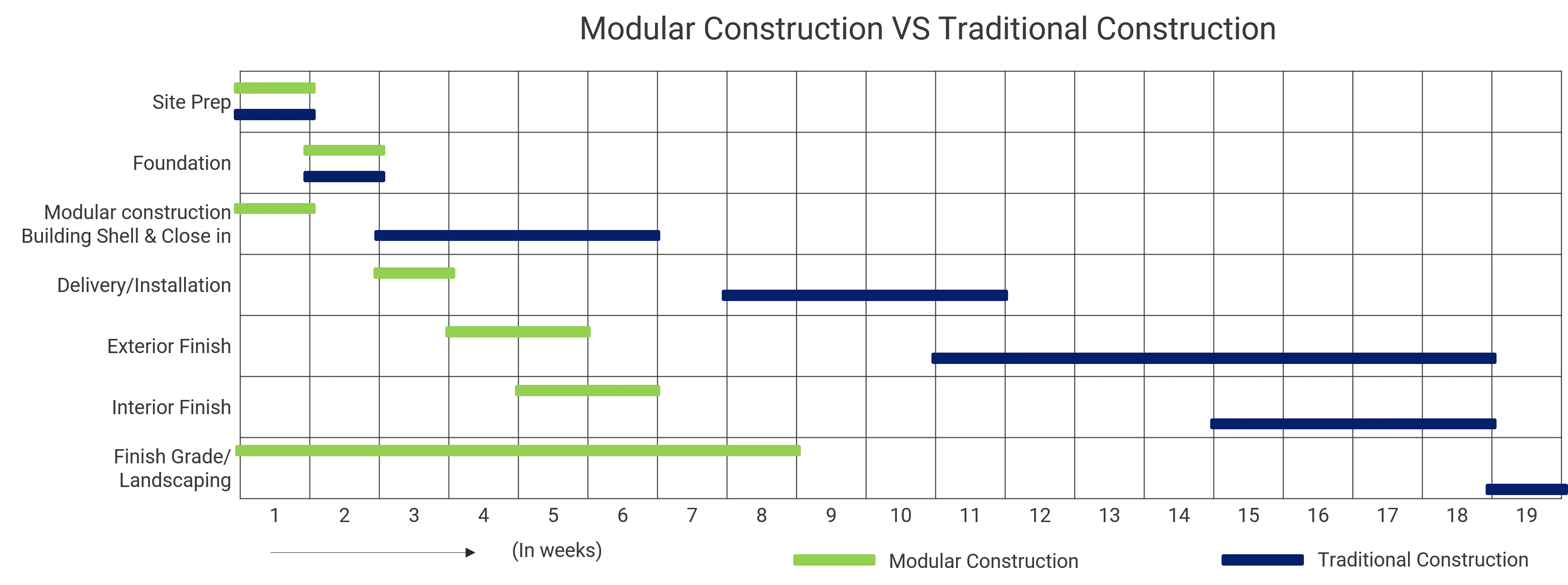
Blog
08th July 2020
Modular construction is the process by which buildings are made up of individual sections ("modules"), constructed in an off-site controlled manufacturing facility, and assembled at the final building site. According to the research conducted by McGraw-Hill Construction, this approach results in a higher-quality building, delivered in a shorter time, with more predictable costs, and fewer environmental impacts like reduced material use and waste. As per the U.S. Labor Department Bureau of Labor Statistics, an off-site construction approach is generally safer for workers, which concluded that rates for fatal injuries were substantially low in overall modular construction manufacturing than in traditional on-site construction.

If affordability and the controlled cost is of primary concern on a project, modular construction can be used to achieve it. For instance, to address the severe lack of affordable housing in London, the city announced in 2017 that it would dedicate USD 32 million to construct a minimum of 1,059 affordably priced modular apartments by the year 2021. Moreover, thousands of modular homes are being built across the UK as cities gear up to tackle the housing shortage; eight of the top 10 housebuilders are now turning to modular construction. Hence affordability and productivity for the increasing population leading urbanization, keeping in mind environmental sustainability is the main driver for the modular construction market. However, a general lack of experience may also keep owners and project teams from feeling comfortable with modular construction, and the lack of awareness about modular construction makes some owners reluctant to try it, resulting in the restraints for the market.
Permanent modular construction is likely to rise more due to the rising need for affordable and time-saving housing solutions, and high-quality control compared to on-site installation. Moreover, permanent modular construction is widely employed in various sectors comprising residential, office and administrative space, K-12 education, retail and hospitality, healthcare, higher education student housing, and publicly-funded facilities. Furthermore, the investments in construction are expected to rise due to expanding structures leading to development. For instance, investor Legal & General launched a modular housing line that will deliver 3,000 homes each year. In comparison, dedicated modular housing developer Ilke Homes has announced a target of 4,000 homes in the next two years. Furthermore, Real Estate was using modular construction as a variety of high-end commercial projects and concluded that the modular construction market is projected to reach as high as USD 157 billion by 2023.
Asia-Pacific, home of two-thirds of the world's people, is experiencing a rise in urbanization that is rapid infrastructure development, including the construction of institutes, roads, bridges, offices, power plants, etc. Adding to it, robotics and drones are being deployed in some construction projects, and a USD 1 billion, the construction tech industry, is projected to exceed 10 Trillion USD by 2020. Moreover, with growing concerns about climate change, there is tremendous pressure across sectors to reduce the impact on the environment, especially by industries that utilize vast amounts of natural resources like construction, responsible for 40% of all energy-related carbon dioxide (CO2) emissions that can be achieved by modular infrastructure. China has over 7,000 prefab manufacturers, more than any other country. That means there are plenty of low-grade factories out there which may sheer number of players and the amount of R&D investment to create options for considering prefab for luxury residential houses. For instance, Last year, the UK's Your Housing Group signed a GBP 2.5 billion deal with the state-owned China National Building Material Company in which the money and the project size are both unprecedented for prefab developments that entail 25,000 new homes over the next five years.
The future of modular construction is likely to be on the positive side due to a severe need to build up health care units in the ongoing pandemic, the need for sustainability, and supporting the economy of the growing nations by the cost-efficient innovations. Moreover, the increasing population leads to rapid urbanization, which is likely to be a significant factor in modular market growth. For instance, Alterra Property Group has landed a USD 120 million loan to build a mixed-use project near downtown Philadelphia marking the firm's third residential development to use modular construction in the city.
Detailed analysis of the Impact of Covid-19 on Modular Construction Market will be available in our Full Report.